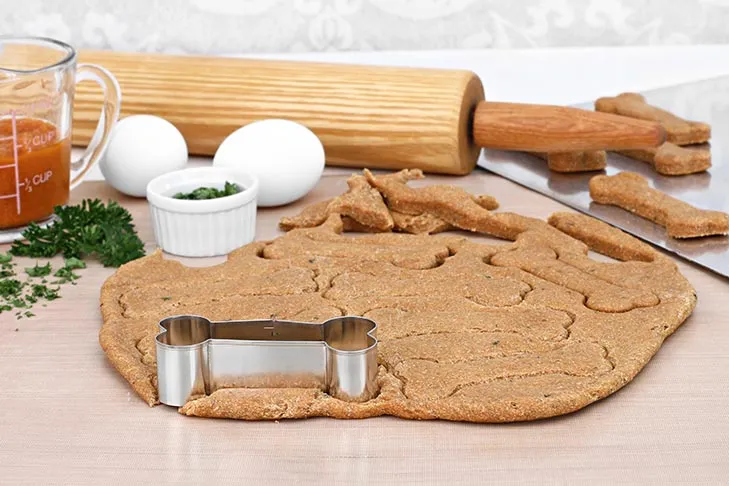In a market overflowing with commercial dog treats, the desire to create wholesome, homemade options for your canine companion is growing. Making your own dog treats gives you complete control over the ingredients, ensuring your beloved pet receives only the best without unwanted additives or preservatives. These carefully selected, vet-approved recipes are designed to be quick, easy, and incredibly fun to make, providing a healthy and delicious way to show your dog some extra love while supporting their overall well-being. Prioritizing fresh, safe ingredients can significantly contribute to your dog’s health, just as choosing the right daily nutrition is vital, whether you’re looking for the best dog food for yorkies or other specialized diets.
Preparing treats at home also offers a rewarding experience for pet owners, fostering a deeper connection through the act of nurturing. Each recipe included here has been chosen for its simplicity, using readily available ingredients that are safe and beneficial for dogs, making it easier than ever to bake up a batch of happiness. From crunchy pretzels to refreshing frozen delights, these homemade dog treats are not only delicious but also align with the nutritional needs approved by veterinary experts.
Delightful Apple Pretzels: A Simple, Healthy Treat
This apple pretzel recipe might seem to have a few steps, but it’s surprisingly easy to master. Made with just three wholesome ingredients, these baked treats are a fantastic way to offer your dog a healthy snack you can feel good about. Plus, if you’ve ever enjoyed baking pretzels yourself, you’ll know how satisfying it is to roll and twist the dough into fun shapes. Your dog won’t be particular about the aesthetics; they will simply adore the delicious, natural apple flavor and the satisfying crunch. This recipe is a perfect weekend project that yields a batch of treats your furry friend will eagerly anticipate.
Ingredients
- 3 cups almond flour
- 1 egg
- 1 cup plain, unsweetened applesauce
Directions
- Preheat oven to 350 degrees Fahrenheit.
- Line a baking sheet with parchment paper and set aside.
- Beat one egg and set aside.
- In a large bowl, mix the applesauce and almond flour.
- Pour 1 tablespoon of the beaten egg into a separate small bowl and set aside; this will be for brushing the pretzels.
- Add the remaining beaten egg to the large bowl with the applesauce and flour mixture.
- Stir the mixture until a cohesive dough forms.
- Take a two-tablespoon-sized piece of dough and roll it into a tube shape.
- Form each tube into a “U” shape, then twist the ends together and fold them back towards the top to create a pretzel shape.
- Place the shaped pretzels onto the prepared baking tray.
- Brush the top of each pretzel with the reserved tablespoon of egg.
- Bake for approximately 25-30 minutes, or until they are lightly browned and firm to the touch.
- Remove from the oven and allow them to cool completely before serving to your dog.
 A small Yorkshire Terrier looks intently at its owner in a bright kitchen, waiting for a treat.
A small Yorkshire Terrier looks intently at its owner in a bright kitchen, waiting for a treat.
Wholesome Blackberry Biscuits: Bursting with Flavor
Next time you visit the farmer’s market, grab some extra blackberries to whip up these delightful, vet-approved blackberry biscuits for your dog. Blackberries are not only delicious but also packed with antioxidants and vitamins beneficial for your dog’s health. These treats are so appealing that you might even find yourself tempted to sneak a bite! They offer a natural sweetness and a wholesome texture that dogs simply adore, making them an excellent alternative to store-bought options that often contain artificial flavors and excessive sugars. Finding the right treats is as important as choosing the best dog food for goldendoodles to maintain a balanced diet for your furry friend.
Ingredients
- 4 cups almond flour
- ¾ cup flax meal
- ½ cup blackberries
- 1 egg
- ¼ cup extra virgin olive oil
- 1 cup water
Directions
- Preheat oven to 350 degrees Fahrenheit.
- Line a baking sheet with parchment paper.
- In a large bowl, mix all ingredients together with 1 cup of water until a firm dough forms.
- Roll the dough until it is approximately 1/4-inch thick.
- Use a small cookie cutter to cut out biscuit shapes from the rolled dough.
- Gather and re-roll any remaining dough, cutting out additional biscuits until all the dough is used.
- Place the biscuits 1 inch apart on the prepared baking sheet.
- Bake for 30 minutes, or until they are nicely browned and firm.
- Remove the biscuits from the oven and allow them to cool completely before serving.
Savory Mini Omelettes: A Protein-Packed Mealtime Snack
These mini omelettes are a fantastic, healthy treat for dogs, offering a rich source of protein without any unnecessary spices, herbs, or butter that might upset their stomachs. While you might add a dash of pepper or a pinch of salt to your own omelette, your dog will appreciate the simple, wholesome flavors of eggs, lean protein, and a touch of bell pepper. They’ll be so engrossed in gobbling down this delicious snack that they won’t even mind if you prepare one for yourself alongside theirs. It’s crucial to remember that raw egg whites can lead to biotin deficiency in dogs, so always ensure the eggs are thoroughly cooked before offering them to your pet.
Ingredients
- 2 eggs (Note: Ensure eggs are cooked all the way through to prevent biotin deficiency.)
- ½ cup cooked, thinly-sliced salmon or pulled grilled chicken (If using chicken, ensure it’s skinless and boneless.)
- ½ green bell pepper, diced
Directions
- Lightly grease a frying pan with a small drizzle of extra virgin olive oil.
- Turn the heat for the frying pan to medium-high.
- Crack the eggs into a bowl and stir with a fork until well mixed.
- Once the frying pan is heated, gently pour the mixed eggs into the center of the pan.
- Tilt the pan to spread the egg mixture evenly across the surface.
- Once the egg is halfway firm, sprinkle on the diced green bell pepper and either the salmon or grilled chicken.
- Using a spatula, carefully fold the egg in half and allow it to continue heating until the egg appears fully firm.
- Remove the omelette from the pan and place it on a plate.
- Allow it to cool completely before cutting into small pieces and serving.
 Various baking tools and ingredients laid out on a clean counter, ready for making homemade dog treats.
Various baking tools and ingredients laid out on a clean counter, ready for making homemade dog treats.
Ensuring your dog receives adequate protein through their diet is essential, whether it’s from homemade treats or their regular meals. When considering your dog’s daily nutrition, particularly for active or large breeds, understanding their specific protein needs can be crucial for their muscle development and energy levels. For example, knowing the best dog food for pitbulls often involves looking for higher protein content to support their strong physique and energetic lifestyle.
Refreshing Frozen Meat Treats: Perfect for Hot Days
Chicken and carrots are often top favorites among dogs, making them ideal base ingredients for these vet-approved frozen meat treats. This recipe adds another delightful component: a touch of plain yogurt, transforming them into a cool, creamy delight. These frozen treats are particularly wonderful for keeping your dog hydrated and happy on warm days. By freezing the mixture in ice cube trays, you can easily create a ready-made stash of healthy, cooling snacks to offer your dog anytime they need a refreshing pick-me-up. Remember, never use yogurt containing xylitol, as it is highly poisonous to dogs.
Ingredients
- 2 cups grilled chicken (ensure the chicken is skinless and boneless)
- ¾ cup plain low-fat or fat-free yogurt (don’t use yogurt with xylitol, which is poisonous to dogs)
- 1 carrot (use a smaller amount if your dog is diabetic)
- 3 tablespoons extra virgin olive oil
Directions
- Stir all the ingredients together thoroughly in a bowl.
- Pour the mixture into ice cube trays, then place them in the freezer until fully solid.
- For smaller dogs or puppies, you can pipe little droplets of the mixture onto a parchment-lined baking sheet before freezing, creating more manageable, bite-sized portions.
Making homemade treats can be an enriching experience, especially when you know exactly what goes into your dog’s diet. For growing pups, careful attention to nutrition is key, which is why many owners seek out specific formulations, such as the best dog food for goldendoodle puppies, to ensure optimal development.
Patriotic Red, White, and Blue Yogurt Popsicles: A Berry Delicious Cool Down
Bursting with fresh berries, these vibrant red, white, and blue popsicles are more than just a patriotic treat for the Fourth of July; they are an ideal way to help your dog cool down on any hot day. Made with wholesome fruits and plain yogurt, they offer a healthy and hydrating snack that’s both delicious and incredibly easy to prepare. Your dog will love the icy texture and the sweet, natural flavors, making these popsicles a perfect refreshing indulgence. As with all treats containing yogurt, be absolutely sure it does not contain xylitol, which is toxic to dogs. If your dog has diabetes, use smaller amounts of strawberries, as they contain natural sugars.
Ingredients
- 1 cup whole blueberries
- 1/2 cup chopped strawberries (use a smaller amount if your dog is diabetic)
- 1 cup plain yogurt (don’t use yogurt containing xylitol, which is poisonous to dogs)
Directions
- Gently mix all ingredients together in a bowl until well combined.
- Pour the mixture into an ice cube tray or a large mold suitable for freezing.
- Freeze for at least 4-5 hours, or until completely solid.
- Remove one popsicle, allow it to temper for a moment, and then let your dog enjoy this frosty, fruity delight!
 A regal Cavalier King Charles Spaniel rests its head on a kitchen table, looking up with pleading eyes.
A regal Cavalier King Charles Spaniel rests its head on a kitchen table, looking up with pleading eyes.
Choosing to prepare homemade, vet-approved dog treats is a wonderful way to ensure your pet enjoys safe, healthy, and delicious snacks without any hidden ingredients. These recipes demonstrate that providing nutritious options for your dog doesn’t have to be complicated or time-consuming. From crunchy baked goods to refreshing frozen delights, each treat offers a unique way to enrich your dog’s diet and show them how much you care. Just as you seek out the best affordable dog food for goldendoodles to balance quality and budget, these homemade treats offer a cost-effective and wholesome alternative. Embrace the joy of baking for your furry friend and delight in their happy tails and eager anticipation.
